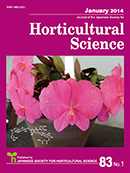Volume 83, Issue 1
Displaying 1-10 of 10 articles from this issue
- |<
- <
- 1
- >
- >|
ORIGINAL ARTICLES
-
Article type: Original Article
2014Volume 83Issue 1 Pages 1-16
Published: 2014
Released on J-STAGE: March 20, 2014
Advance online publication: December 07, 2013Download PDF (1581K) Full view HTML -
Article type: Original Article
2014Volume 83Issue 1 Pages 17-22
Published: 2014
Released on J-STAGE: March 20, 2014
Advance online publication: December 19, 2013Download PDF (1383K) Full view HTML -
Article type: Original Article
2014Volume 83Issue 1 Pages 23-31
Published: 2014
Released on J-STAGE: March 20, 2014
Advance online publication: December 20, 2013Download PDF (1321K) Full view HTML -
Article type: Original Article
2014Volume 83Issue 1 Pages 32-43
Published: 2014
Released on J-STAGE: March 20, 2014
Advance online publication: December 28, 2013Download PDF (1329K) Full view HTML -
Article type: Original Article
2014Volume 83Issue 1 Pages 44-51
Published: 2014
Released on J-STAGE: March 20, 2014
Advance online publication: December 03, 2013Download PDF (955K) Full view HTML -
Article type: Original Article
2014Volume 83Issue 1 Pages 52-58
Published: 2014
Released on J-STAGE: March 20, 2014
Advance online publication: December 03, 2013Download PDF (1275K) Full view HTML -
Article type: Original Article
2014Volume 83Issue 1 Pages 59-63
Published: 2014
Released on J-STAGE: March 20, 2014
Advance online publication: December 07, 2013Download PDF (908K) Full view HTML -
Acylated Cyanidin 3,7-Diglucosides in the Red-purple Flowers of Sophronitis wittigiana (Orchidaceae)Article type: Original Article
2014Volume 83Issue 1 Pages 64-71
Published: 2014
Released on J-STAGE: March 20, 2014
Advance online publication: December 03, 2013Download PDF (1021K) Full view HTML -
Article type: Original Article
2014Volume 83Issue 1 Pages 72-80
Published: 2014
Released on J-STAGE: March 20, 2014
Advance online publication: December 19, 2013Download PDF (1203K) Full view HTML -
Article type: Original Article
2014Volume 83Issue 1 Pages 81-89
Published: 2014
Released on J-STAGE: March 20, 2014
Advance online publication: December 03, 2013Download PDF (869K) Full view HTML
- |<
- <
- 1
- >
- >|
